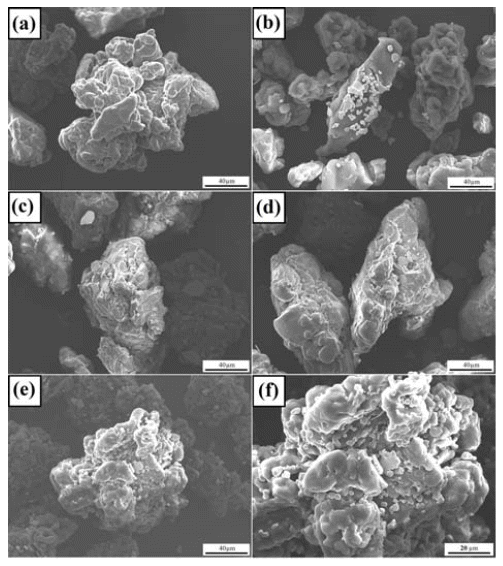Search
- Page Path
- HOME > Search
- [English]
- Synthesis of Carbonyl Iron-reinforced Polystyrene by High Energy Ball Milling
- Hong-Hai Nguyen, Minh-Thuyet Nguyen, Won Joo Kim, Jin-Chun Kim, Young-Soo Kim, Young-Hyuk Kim, Olga B. Nazarenko
- J Korean Powder Metall Inst. 2016;23(4):276-281. Published online August 1, 2016
- DOI: https://doi.org/10.4150/KPMI.2016.23.4.276

- 874 View
- 5 Download
- 1 Citations
-
 Abstract
Abstract
 PDF
PDF Carbonyl iron (CI) is successfully incorporated as an additive into a polystyrene (PS) matrix via a highenergy ball milling method, under an n-hexane medium with volume fractions between 1% and 5% for electromagnetic interference shielding applications by the combination of magnetic CI and an insulating PS matrix. The morphology and the dispersion of CI are investigated by field emission scanning electron microscopy, which indicates a uniform distribution of CI in the PS matrix after 2 h of milling. The thermal behavior results indicate no significant degradation of the PS when there is a slight increase in the onset temperature with the addition of CI powder, when compared to the as-received PS pellet. After milling, there are no interactions between the CI and the PS matrix, as confirmed by Fourier transformed infrared spectroscopy. In this study, the milled CI-PS powder is extruded to make filaments, and can have potential applications in the 3-D printing industry.
-
Citations
Citations to this article as recorded by- Progress toward sustainable polymer technologies with ball-mill grinding
Antonio Rizzo, Gregory I. Peterson
Progress in Polymer Science.2024; 159: 101900. CrossRef
- Progress toward sustainable polymer technologies with ball-mill grinding
- [Korean]
- Fabrication of ZnO Nanorod/polystyrene Nanosphere Hybrid Nanostructures by Hydrothermal Method for Energy Generation Applications
- Seong-Ho Baek, Il-Kyu Park
- J Korean Powder Metall Inst. 2015;22(6):391-395. Published online December 1, 2015
- DOI: https://doi.org/10.4150/KPMI.2015.22.6.391

- 782 View
- 3 Download
- 4 Citations
-
 Abstract
Abstract
 PDF
PDF We report on the successful fabrication of ZnO nanorod (NR)/polystyrene (PS) nanosphere hybrid nanostructure by combining drop coating and hydrothermal methods. Especially, by adopting an atomic layer deposition method for seed layer formation, very uniform ZnO NR structure is grown on the complicated PS surfaces. By using zinc nitrate hexahydrate [Zn(NO3)2 ·6H2O] and hexamine [(CH2)6N4] as sources for Zn and O in hydrothermal process, hexagonal shaped single crystal ZnO NRs are synthesized without dissolution of PS in hydrothermal solution. X-ray diffraction results show that the ZnO NRs are grown along c-axis with single crystalline structure and there is no trace of impurities or unintentionally formed intermetallic compounds. Photoluminescence spectrum measured at room temperature for the ZnO NRs on flat Si and PS show typical two emission bands, which are corresponding to the band-edge and deep level emissions in ZnO crystal. Based on these structural and optical investigations, we confirm that the ZnO NRs can be grown well even on the complicated PS surface morphology to form the chestnut-shaped hybrid nanostructures for the energy generation and storage applications.
-
Citations
Citations to this article as recorded by- Synthesis of Planar-Type ZnO Powder in Non-Nano Scale Dimension and Its Application in Ultraviolet Protection Cosmetics
Jung-Hwan Lee, Gun-Sub Lee, Eung-Nam Park, Dong-Hyeon Jo, So-Won Kim, Hee-Chul Lee
Materials.2023; 16(5): 2099. CrossRef - Rapid consolidation of nanostuctured WC-FeAl3 by pulsed current activated heating and its mechanical properties
In-Jin Shon, Seok-Jae Lee
International Journal of Refractory Metals and Hard Materials.2017; 65: 69. CrossRef - Fabrication of a Graphene/ZnO based p-n junction device and its ultraviolet photoresponse properties
Young-Tae Kwon, Sung-Oong Kang, Ji-Ae Cheon, Yoseb Song, Jong-Jin Lee, Yong-Ho Choa
Applied Surface Science.2017; 415: 2. CrossRef - Morphology Control of ZnO Nanostructures by Surfactants During Hydrothermal Growth
Il-Kyu Park
Journal of Korean Powder Metallurgy Institute.2016; 23(4): 270. CrossRef
- Synthesis of Planar-Type ZnO Powder in Non-Nano Scale Dimension and Its Application in Ultraviolet Protection Cosmetics
TOP
 KPMI
KPMI


 First
First Prev
Prev


